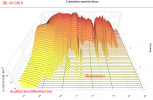Okay, I'm looking at two reviews, and trying to see if I should get one or the other I'll post links below. After that I'll let you know my thinking, but you might want to write your comments in the reply box before reading that bit, so as not to colour your judgement.
There's also a bit of an objectivist philosophical question at the end too, if you're interested.
Revel M16:
This is a review and detailed measurements of the Revel M16 stand-mount/bookshelf speaker. I purchased this through my company and it arrived a few days ago. Can't tell you my cost :), but retail price is US $900 (sold $450 each). As you can expect, when you pay more, you do get more as far...

www.audiosciencereview.com
Wharfedale Diamond 12.1:
This is a review and detailed measurements of the Wharfedale Diamond 12.1 bookshelf speaker. It was kindly purchased by a member and drop shipped to me. It costs US $399 for a pair. The look and feel of the 12.1 is definitely above the budget category: The back is rather pedestrian but...

www.audiosciencereview.com
Okay, what do you think? Compare and contrast, etc.
Now read on.
Both great speakers. Both low distortion. Both have a lovely, flat frequency response, except the Revels +3.5db at c.100hz, and the Wharfedales -4db at around 2khz.
I'm thinking of buying a WiiM amp, which has two attractions: a sub out with bass management, and PEQ. Now, the PEQ should be able to even out the FR bumps, no problem. But here's the thing, if I'm using the sub out, and I use the PEQ to dip the bass on the Revels at 100hz, that's going to be an area in the middle of the crossover with the sub, so I'll be dipping part of the signal to the sub, too (hope that makes sense). But if I raise the 2khz dip on the Wharfedales, nothing else gets in the way. Now, at the moment in the UK the M16s are £500-£550. The 12.1s are £250. Given that the latter would suit what I'm wanting to do more, isn't that a no-brainer?
But I might be missing something in the review. Which is why I'm asking.
The philosophical objectivist question is pretty clear. Can a £250 possibly sound as good as a £500 speaker...actually, when they first appeared the Revels were closer to £1,000. I know, I know, money can be misleading in hi-fi, but nonetheless that's a crazy comparison.
Isn't it?
Happy to hear anyone else's opinions.
Thanks in advance.


